Finance in Hospitality: A Comprehensive Analysis of Funding and Costs
VerifiedAdded on 2020/07/22
|15
|2707
|75
Report
AI Summary
This report provides a comprehensive overview of financial management within the hospitality industry, using Crown Plaza as a case study. It explores diverse sources of funding for both new and existing businesses, including personal investment, venture capital, bank loans, debentures, and retained earnings, while also examining various methods of generating income like sales promotion and sponsorships. The report delves into the crucial elements of costs, including material, labor, and overhead expenses, along with methods for controlling stock and cash. It also addresses trial balances, business account evaluation, budgetary control processes, and variance analysis. Furthermore, the report computes and analyzes key financial ratios such as sales growth, gross profit margin, net profit margin, stock turnover, acid test ratio, and current assets ratio for Grimes Theme Parks and Giants House Theme Park, offering recommendations based on the findings. The report concludes with a discussion of cost categorization, contribution per unit calculations, and justifications for short-term management decisions, providing a well-rounded analysis of financial concepts within the hospitality sector.
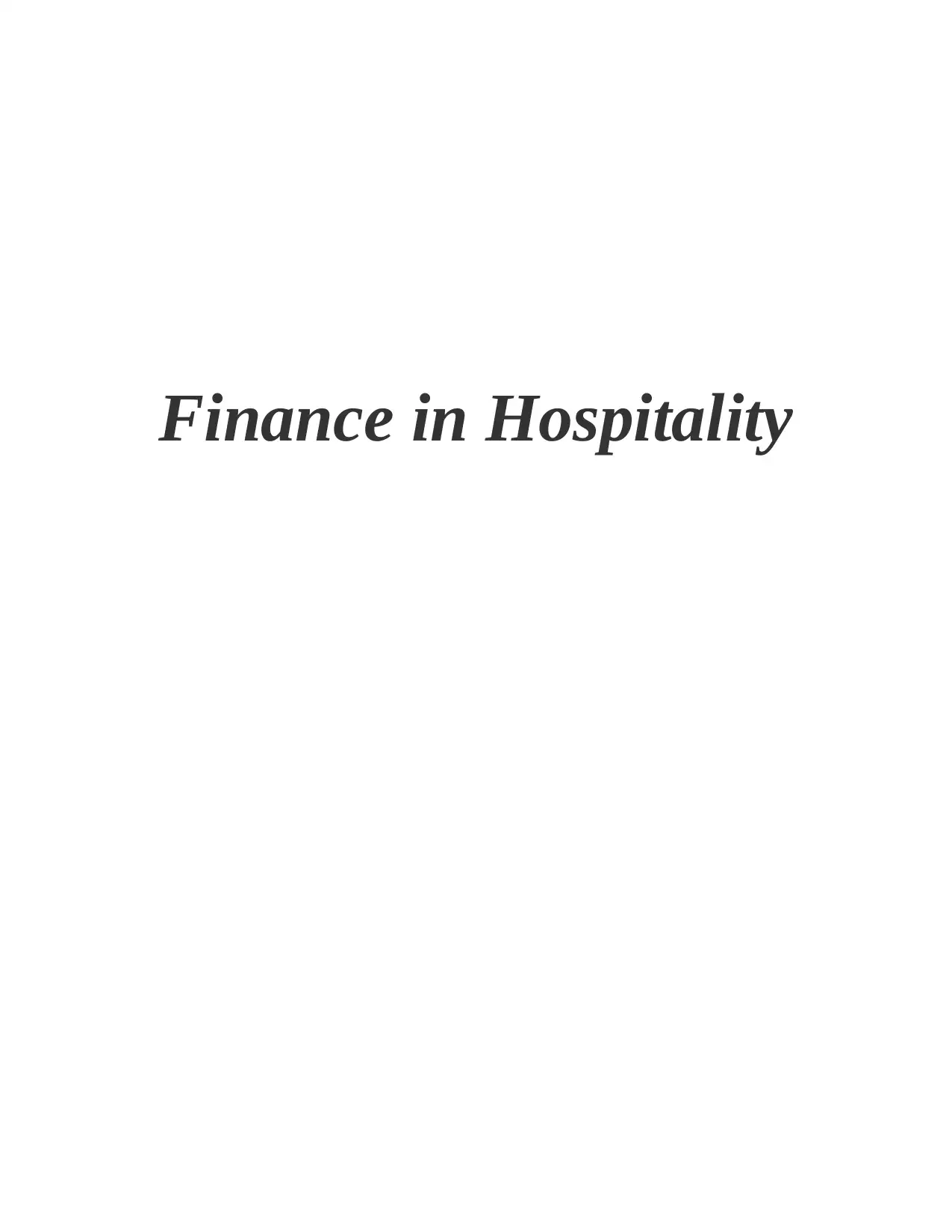
Finance in Hospitality
Paraphrase This Document
Need a fresh take? Get an instant paraphrase of this document with our AI Paraphraser
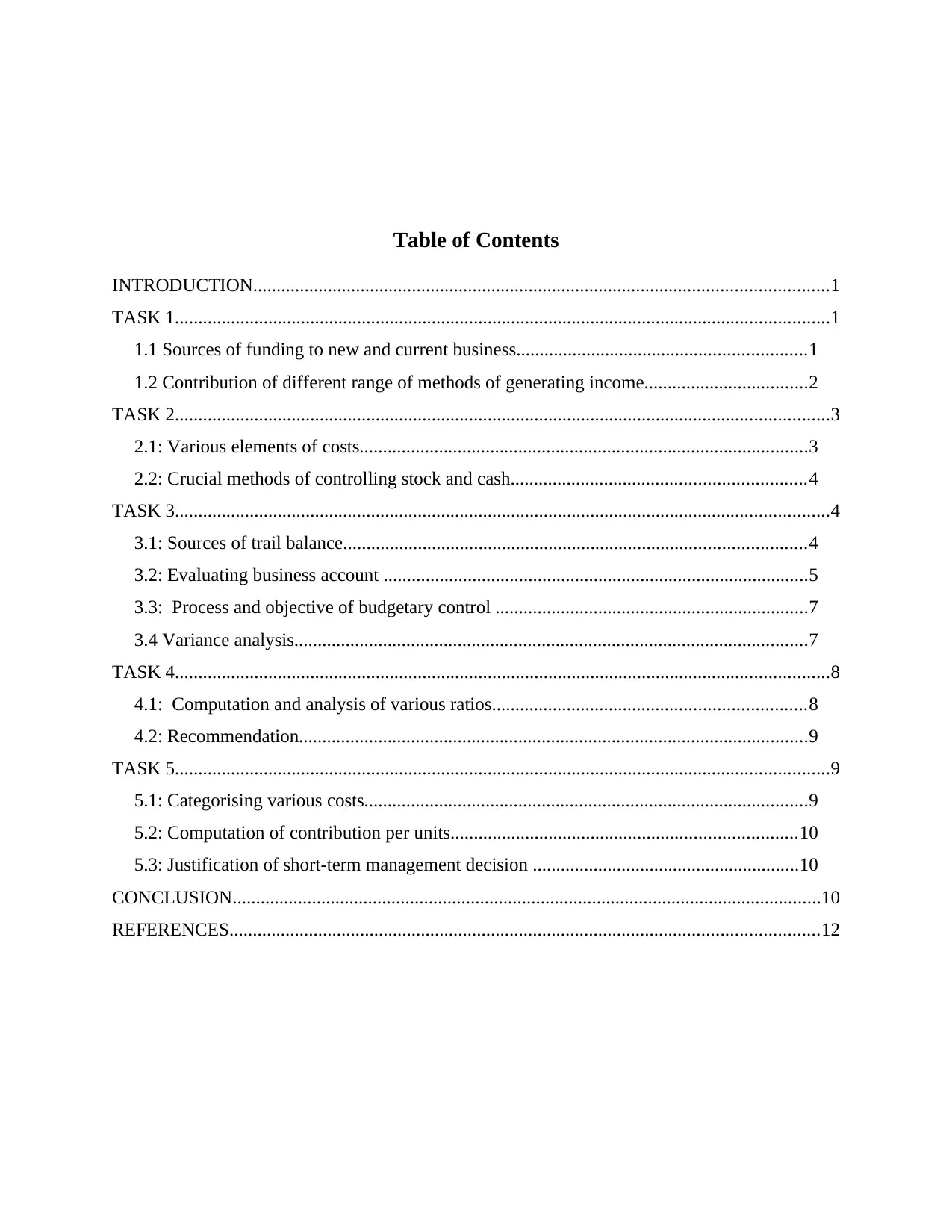
Table of Contents
INTRODUCTION...........................................................................................................................1
TASK 1............................................................................................................................................1
1.1 Sources of funding to new and current business..............................................................1
1.2 Contribution of different range of methods of generating income...................................2
TASK 2............................................................................................................................................3
2.1: Various elements of costs................................................................................................3
2.2: Crucial methods of controlling stock and cash...............................................................4
TASK 3............................................................................................................................................4
3.1: Sources of trail balance...................................................................................................4
3.2: Evaluating business account ...........................................................................................5
3.3: Process and objective of budgetary control ...................................................................7
3.4 Variance analysis..............................................................................................................7
TASK 4............................................................................................................................................8
4.1: Computation and analysis of various ratios...................................................................8
4.2: Recommendation.............................................................................................................9
TASK 5............................................................................................................................................9
5.1: Categorising various costs...............................................................................................9
5.2: Computation of contribution per units..........................................................................10
5.3: Justification of short-term management decision .........................................................10
CONCLUSION..............................................................................................................................10
REFERENCES..............................................................................................................................12
INTRODUCTION...........................................................................................................................1
TASK 1............................................................................................................................................1
1.1 Sources of funding to new and current business..............................................................1
1.2 Contribution of different range of methods of generating income...................................2
TASK 2............................................................................................................................................3
2.1: Various elements of costs................................................................................................3
2.2: Crucial methods of controlling stock and cash...............................................................4
TASK 3............................................................................................................................................4
3.1: Sources of trail balance...................................................................................................4
3.2: Evaluating business account ...........................................................................................5
3.3: Process and objective of budgetary control ...................................................................7
3.4 Variance analysis..............................................................................................................7
TASK 4............................................................................................................................................8
4.1: Computation and analysis of various ratios...................................................................8
4.2: Recommendation.............................................................................................................9
TASK 5............................................................................................................................................9
5.1: Categorising various costs...............................................................................................9
5.2: Computation of contribution per units..........................................................................10
5.3: Justification of short-term management decision .........................................................10
CONCLUSION..............................................................................................................................10
REFERENCES..............................................................................................................................12

⊘ This is a preview!⊘
Do you want full access?
Subscribe today to unlock all pages.

Trusted by 1+ million students worldwide
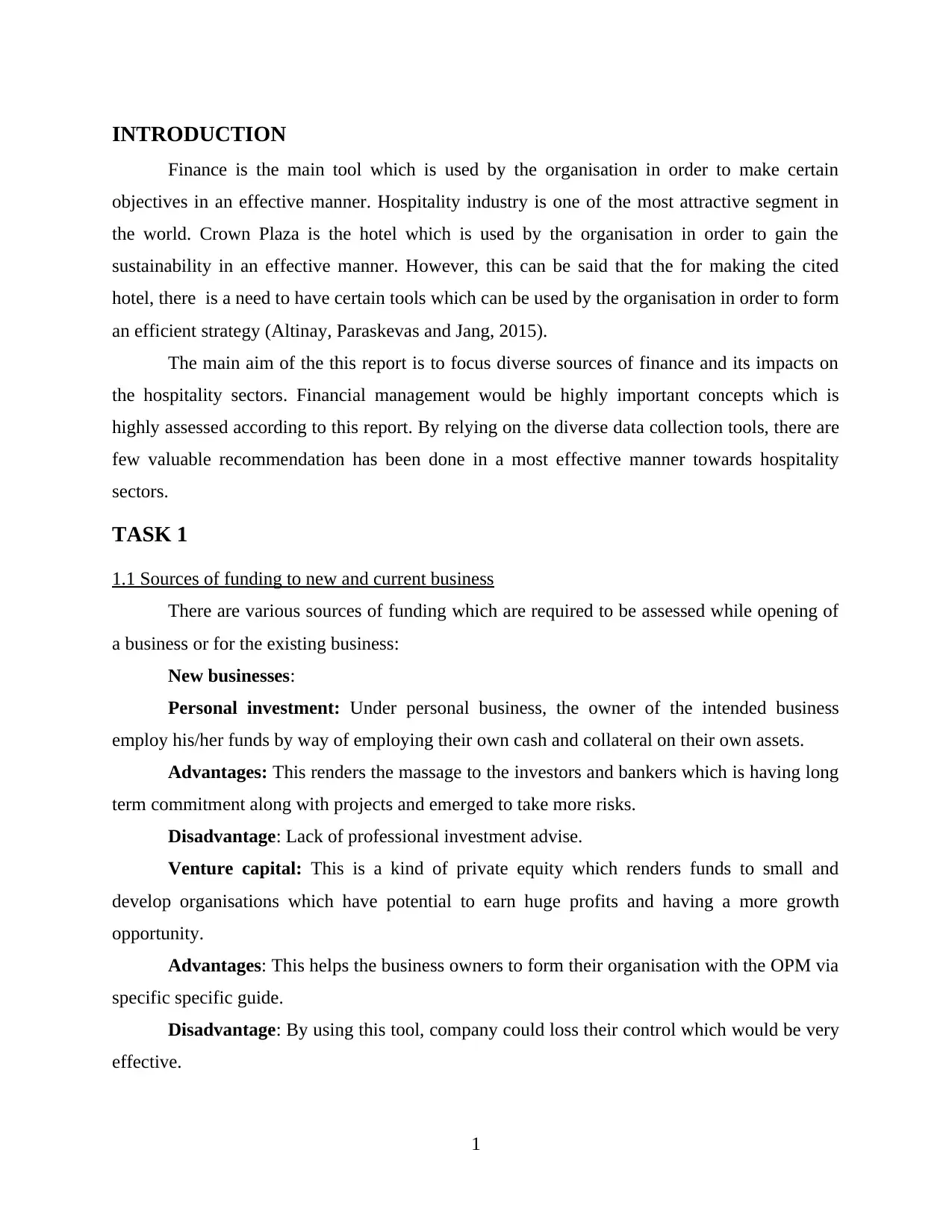
INTRODUCTION
Finance is the main tool which is used by the organisation in order to make certain
objectives in an effective manner. Hospitality industry is one of the most attractive segment in
the world. Crown Plaza is the hotel which is used by the organisation in order to gain the
sustainability in an effective manner. However, this can be said that the for making the cited
hotel, there is a need to have certain tools which can be used by the organisation in order to form
an efficient strategy (Altinay, Paraskevas and Jang, 2015).
The main aim of the this report is to focus diverse sources of finance and its impacts on
the hospitality sectors. Financial management would be highly important concepts which is
highly assessed according to this report. By relying on the diverse data collection tools, there are
few valuable recommendation has been done in a most effective manner towards hospitality
sectors.
TASK 1
1.1 Sources of funding to new and current business
There are various sources of funding which are required to be assessed while opening of
a business or for the existing business:
New businesses:
Personal investment: Under personal business, the owner of the intended business
employ his/her funds by way of employing their own cash and collateral on their own assets.
Advantages: This renders the massage to the investors and bankers which is having long
term commitment along with projects and emerged to take more risks.
Disadvantage: Lack of professional investment advise.
Venture capital: This is a kind of private equity which renders funds to small and
develop organisations which have potential to earn huge profits and having a more growth
opportunity.
Advantages: This helps the business owners to form their organisation with the OPM via
specific specific guide.
Disadvantage: By using this tool, company could loss their control which would be very
effective.
1
Finance is the main tool which is used by the organisation in order to make certain
objectives in an effective manner. Hospitality industry is one of the most attractive segment in
the world. Crown Plaza is the hotel which is used by the organisation in order to gain the
sustainability in an effective manner. However, this can be said that the for making the cited
hotel, there is a need to have certain tools which can be used by the organisation in order to form
an efficient strategy (Altinay, Paraskevas and Jang, 2015).
The main aim of the this report is to focus diverse sources of finance and its impacts on
the hospitality sectors. Financial management would be highly important concepts which is
highly assessed according to this report. By relying on the diverse data collection tools, there are
few valuable recommendation has been done in a most effective manner towards hospitality
sectors.
TASK 1
1.1 Sources of funding to new and current business
There are various sources of funding which are required to be assessed while opening of
a business or for the existing business:
New businesses:
Personal investment: Under personal business, the owner of the intended business
employ his/her funds by way of employing their own cash and collateral on their own assets.
Advantages: This renders the massage to the investors and bankers which is having long
term commitment along with projects and emerged to take more risks.
Disadvantage: Lack of professional investment advise.
Venture capital: This is a kind of private equity which renders funds to small and
develop organisations which have potential to earn huge profits and having a more growth
opportunity.
Advantages: This helps the business owners to form their organisation with the OPM via
specific specific guide.
Disadvantage: By using this tool, company could loss their control which would be very
effective.
1
Paraphrase This Document
Need a fresh take? Get an instant paraphrase of this document with our AI Paraphraser
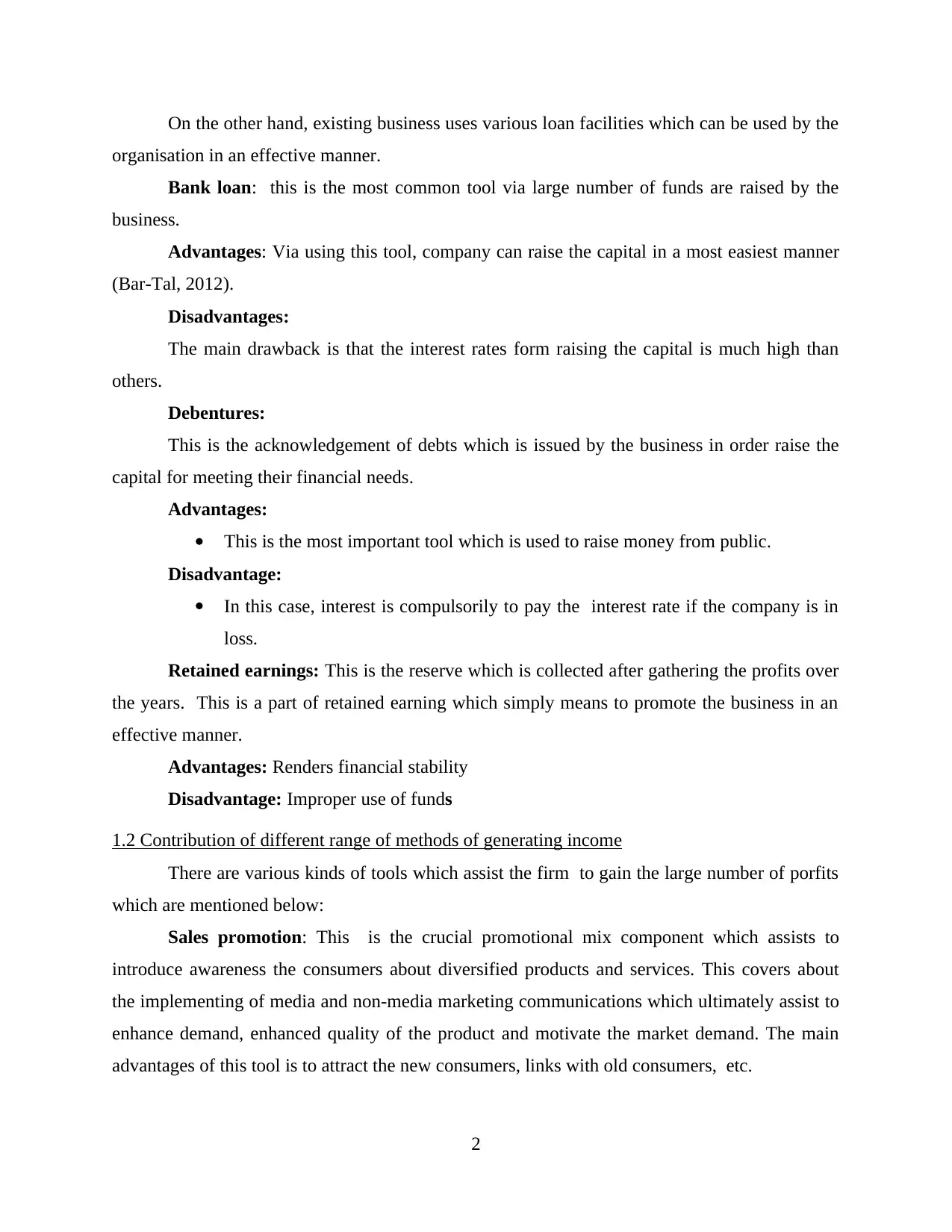
On the other hand, existing business uses various loan facilities which can be used by the
organisation in an effective manner.
Bank loan: this is the most common tool via large number of funds are raised by the
business.
Advantages: Via using this tool, company can raise the capital in a most easiest manner
(Bar-Tal, 2012).
Disadvantages:
The main drawback is that the interest rates form raising the capital is much high than
others.
Debentures:
This is the acknowledgement of debts which is issued by the business in order raise the
capital for meeting their financial needs.
Advantages:
This is the most important tool which is used to raise money from public.
Disadvantage:
In this case, interest is compulsorily to pay the interest rate if the company is in
loss.
Retained earnings: This is the reserve which is collected after gathering the profits over
the years. This is a part of retained earning which simply means to promote the business in an
effective manner.
Advantages: Renders financial stability
Disadvantage: Improper use of funds
1.2 Contribution of different range of methods of generating income
There are various kinds of tools which assist the firm to gain the large number of porfits
which are mentioned below:
Sales promotion: This is the crucial promotional mix component which assists to
introduce awareness the consumers about diversified products and services. This covers about
the implementing of media and non-media marketing communications which ultimately assist to
enhance demand, enhanced quality of the product and motivate the market demand. The main
advantages of this tool is to attract the new consumers, links with old consumers, etc.
2
organisation in an effective manner.
Bank loan: this is the most common tool via large number of funds are raised by the
business.
Advantages: Via using this tool, company can raise the capital in a most easiest manner
(Bar-Tal, 2012).
Disadvantages:
The main drawback is that the interest rates form raising the capital is much high than
others.
Debentures:
This is the acknowledgement of debts which is issued by the business in order raise the
capital for meeting their financial needs.
Advantages:
This is the most important tool which is used to raise money from public.
Disadvantage:
In this case, interest is compulsorily to pay the interest rate if the company is in
loss.
Retained earnings: This is the reserve which is collected after gathering the profits over
the years. This is a part of retained earning which simply means to promote the business in an
effective manner.
Advantages: Renders financial stability
Disadvantage: Improper use of funds
1.2 Contribution of different range of methods of generating income
There are various kinds of tools which assist the firm to gain the large number of porfits
which are mentioned below:
Sales promotion: This is the crucial promotional mix component which assists to
introduce awareness the consumers about diversified products and services. This covers about
the implementing of media and non-media marketing communications which ultimately assist to
enhance demand, enhanced quality of the product and motivate the market demand. The main
advantages of this tool is to attract the new consumers, links with old consumers, etc.
2
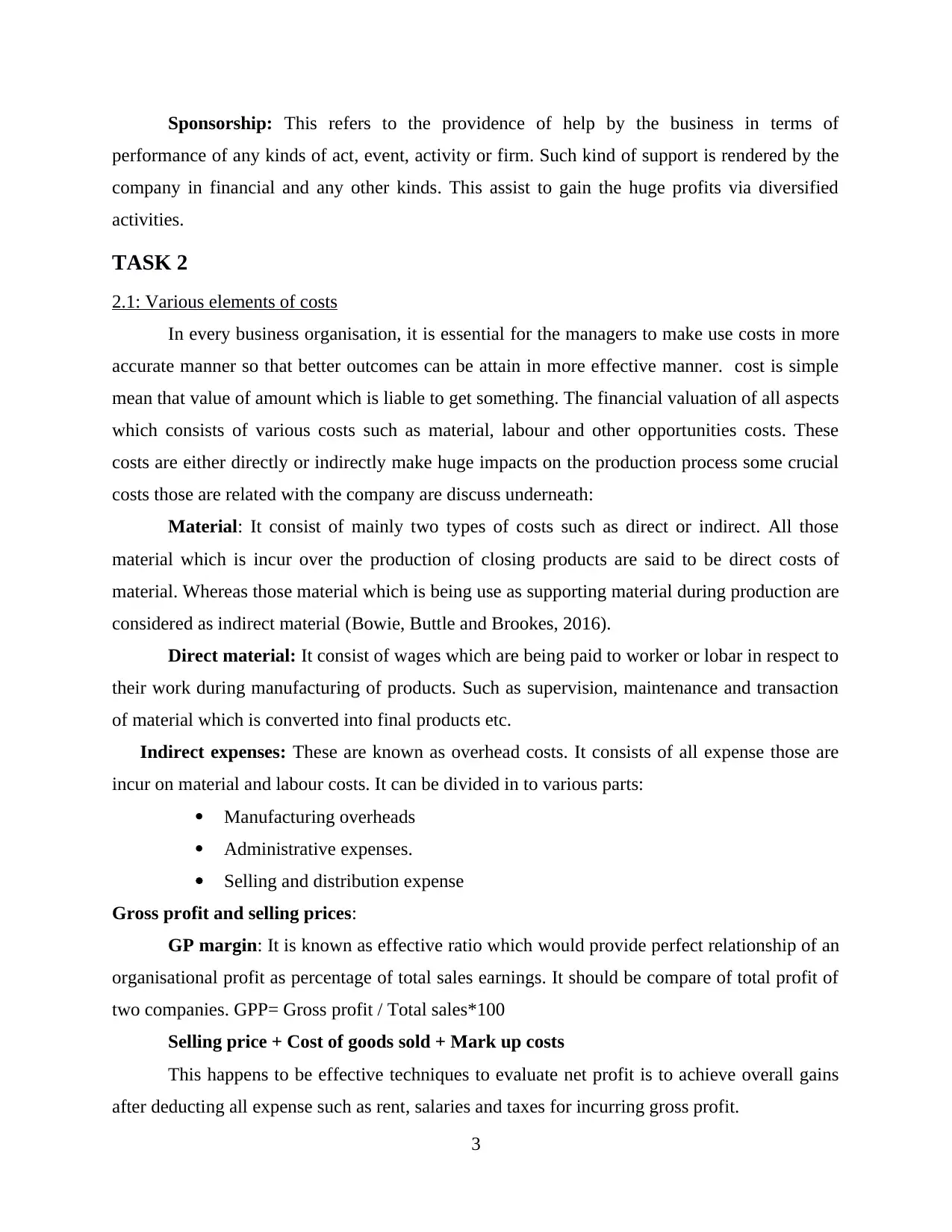
Sponsorship: This refers to the providence of help by the business in terms of
performance of any kinds of act, event, activity or firm. Such kind of support is rendered by the
company in financial and any other kinds. This assist to gain the huge profits via diversified
activities.
TASK 2
2.1: Various elements of costs
In every business organisation, it is essential for the managers to make use costs in more
accurate manner so that better outcomes can be attain in more effective manner. cost is simple
mean that value of amount which is liable to get something. The financial valuation of all aspects
which consists of various costs such as material, labour and other opportunities costs. These
costs are either directly or indirectly make huge impacts on the production process some crucial
costs those are related with the company are discuss underneath:
Material: It consist of mainly two types of costs such as direct or indirect. All those
material which is incur over the production of closing products are said to be direct costs of
material. Whereas those material which is being use as supporting material during production are
considered as indirect material (Bowie, Buttle and Brookes, 2016).
Direct material: It consist of wages which are being paid to worker or lobar in respect to
their work during manufacturing of products. Such as supervision, maintenance and transaction
of material which is converted into final products etc.
Indirect expenses: These are known as overhead costs. It consists of all expense those are
incur on material and labour costs. It can be divided in to various parts:
Manufacturing overheads
Administrative expenses.
Selling and distribution expense
Gross profit and selling prices:
GP margin: It is known as effective ratio which would provide perfect relationship of an
organisational profit as percentage of total sales earnings. It should be compare of total profit of
two companies. GPP= Gross profit / Total sales*100
Selling price + Cost of goods sold + Mark up costs
This happens to be effective techniques to evaluate net profit is to achieve overall gains
after deducting all expense such as rent, salaries and taxes for incurring gross profit.
3
performance of any kinds of act, event, activity or firm. Such kind of support is rendered by the
company in financial and any other kinds. This assist to gain the huge profits via diversified
activities.
TASK 2
2.1: Various elements of costs
In every business organisation, it is essential for the managers to make use costs in more
accurate manner so that better outcomes can be attain in more effective manner. cost is simple
mean that value of amount which is liable to get something. The financial valuation of all aspects
which consists of various costs such as material, labour and other opportunities costs. These
costs are either directly or indirectly make huge impacts on the production process some crucial
costs those are related with the company are discuss underneath:
Material: It consist of mainly two types of costs such as direct or indirect. All those
material which is incur over the production of closing products are said to be direct costs of
material. Whereas those material which is being use as supporting material during production are
considered as indirect material (Bowie, Buttle and Brookes, 2016).
Direct material: It consist of wages which are being paid to worker or lobar in respect to
their work during manufacturing of products. Such as supervision, maintenance and transaction
of material which is converted into final products etc.
Indirect expenses: These are known as overhead costs. It consists of all expense those are
incur on material and labour costs. It can be divided in to various parts:
Manufacturing overheads
Administrative expenses.
Selling and distribution expense
Gross profit and selling prices:
GP margin: It is known as effective ratio which would provide perfect relationship of an
organisational profit as percentage of total sales earnings. It should be compare of total profit of
two companies. GPP= Gross profit / Total sales*100
Selling price + Cost of goods sold + Mark up costs
This happens to be effective techniques to evaluate net profit is to achieve overall gains
after deducting all expense such as rent, salaries and taxes for incurring gross profit.
3
⊘ This is a preview!⊘
Do you want full access?
Subscribe today to unlock all pages.

Trusted by 1+ million students worldwide
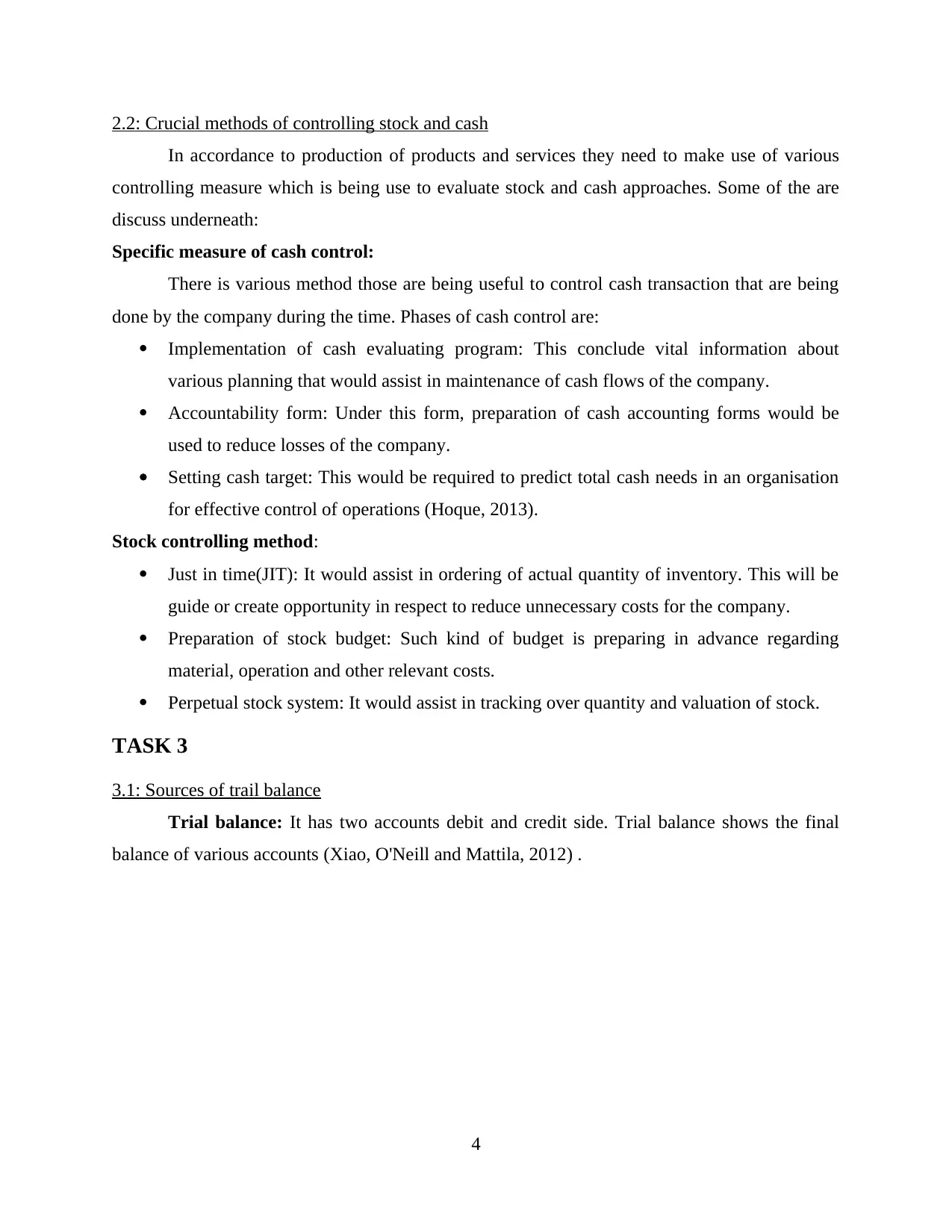
2.2: Crucial methods of controlling stock and cash
In accordance to production of products and services they need to make use of various
controlling measure which is being use to evaluate stock and cash approaches. Some of the are
discuss underneath:
Specific measure of cash control:
There is various method those are being useful to control cash transaction that are being
done by the company during the time. Phases of cash control are:
Implementation of cash evaluating program: This conclude vital information about
various planning that would assist in maintenance of cash flows of the company.
Accountability form: Under this form, preparation of cash accounting forms would be
used to reduce losses of the company.
Setting cash target: This would be required to predict total cash needs in an organisation
for effective control of operations (Hoque, 2013).
Stock controlling method:
Just in time(JIT): It would assist in ordering of actual quantity of inventory. This will be
guide or create opportunity in respect to reduce unnecessary costs for the company.
Preparation of stock budget: Such kind of budget is preparing in advance regarding
material, operation and other relevant costs.
Perpetual stock system: It would assist in tracking over quantity and valuation of stock.
TASK 3
3.1: Sources of trail balance
Trial balance: It has two accounts debit and credit side. Trial balance shows the final
balance of various accounts (Xiao, O'Neill and Mattila, 2012) .
4
In accordance to production of products and services they need to make use of various
controlling measure which is being use to evaluate stock and cash approaches. Some of the are
discuss underneath:
Specific measure of cash control:
There is various method those are being useful to control cash transaction that are being
done by the company during the time. Phases of cash control are:
Implementation of cash evaluating program: This conclude vital information about
various planning that would assist in maintenance of cash flows of the company.
Accountability form: Under this form, preparation of cash accounting forms would be
used to reduce losses of the company.
Setting cash target: This would be required to predict total cash needs in an organisation
for effective control of operations (Hoque, 2013).
Stock controlling method:
Just in time(JIT): It would assist in ordering of actual quantity of inventory. This will be
guide or create opportunity in respect to reduce unnecessary costs for the company.
Preparation of stock budget: Such kind of budget is preparing in advance regarding
material, operation and other relevant costs.
Perpetual stock system: It would assist in tracking over quantity and valuation of stock.
TASK 3
3.1: Sources of trail balance
Trial balance: It has two accounts debit and credit side. Trial balance shows the final
balance of various accounts (Xiao, O'Neill and Mattila, 2012) .
4
Paraphrase This Document
Need a fresh take? Get an instant paraphrase of this document with our AI Paraphraser
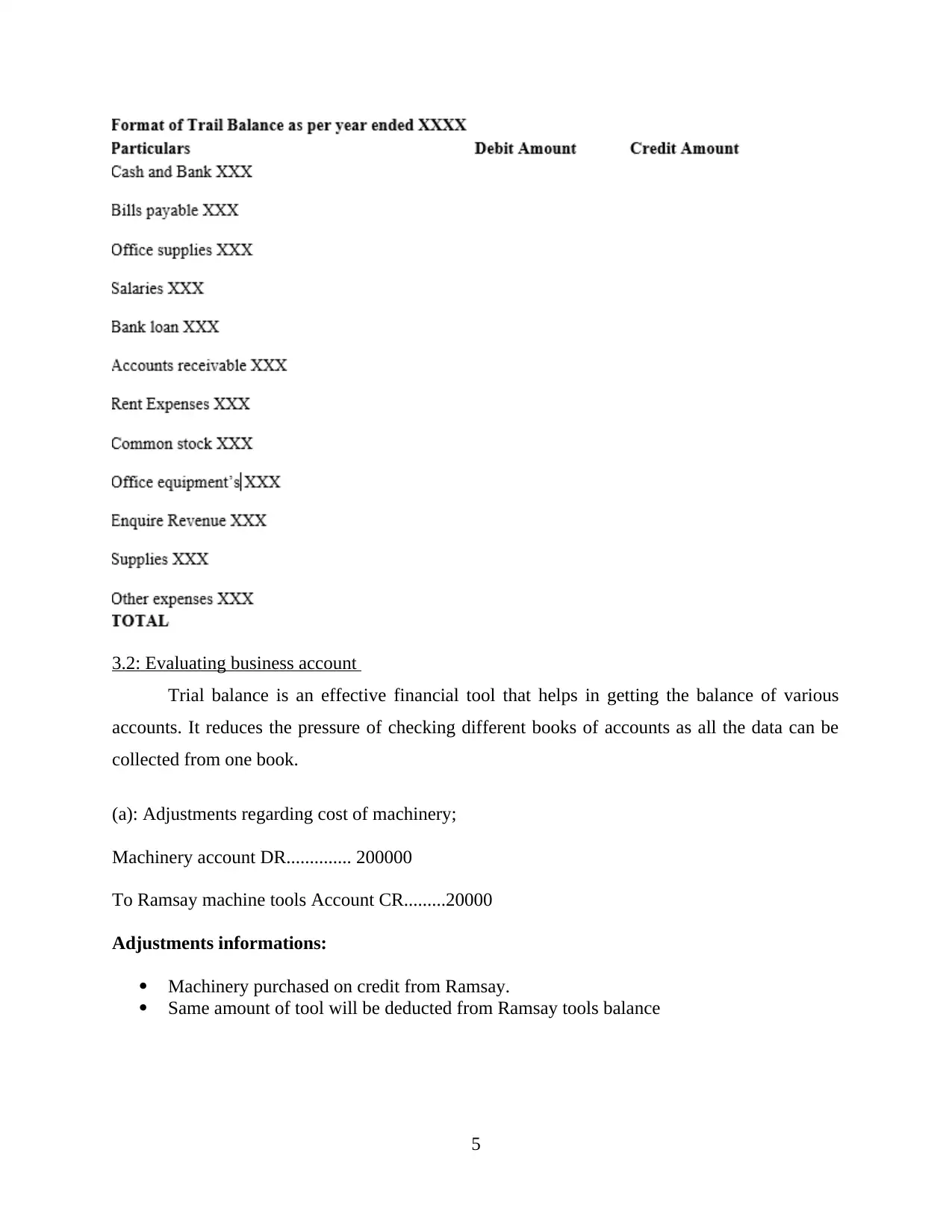
3.2: Evaluating business account
Trial balance is an effective financial tool that helps in getting the balance of various
accounts. It reduces the pressure of checking different books of accounts as all the data can be
collected from one book.
(a): Adjustments regarding cost of machinery;
Machinery account DR.............. 200000
To Ramsay machine tools Account CR.........20000
Adjustments informations:
Machinery purchased on credit from Ramsay.
Same amount of tool will be deducted from Ramsay tools balance
5
Trial balance is an effective financial tool that helps in getting the balance of various
accounts. It reduces the pressure of checking different books of accounts as all the data can be
collected from one book.
(a): Adjustments regarding cost of machinery;
Machinery account DR.............. 200000
To Ramsay machine tools Account CR.........20000
Adjustments informations:
Machinery purchased on credit from Ramsay.
Same amount of tool will be deducted from Ramsay tools balance
5
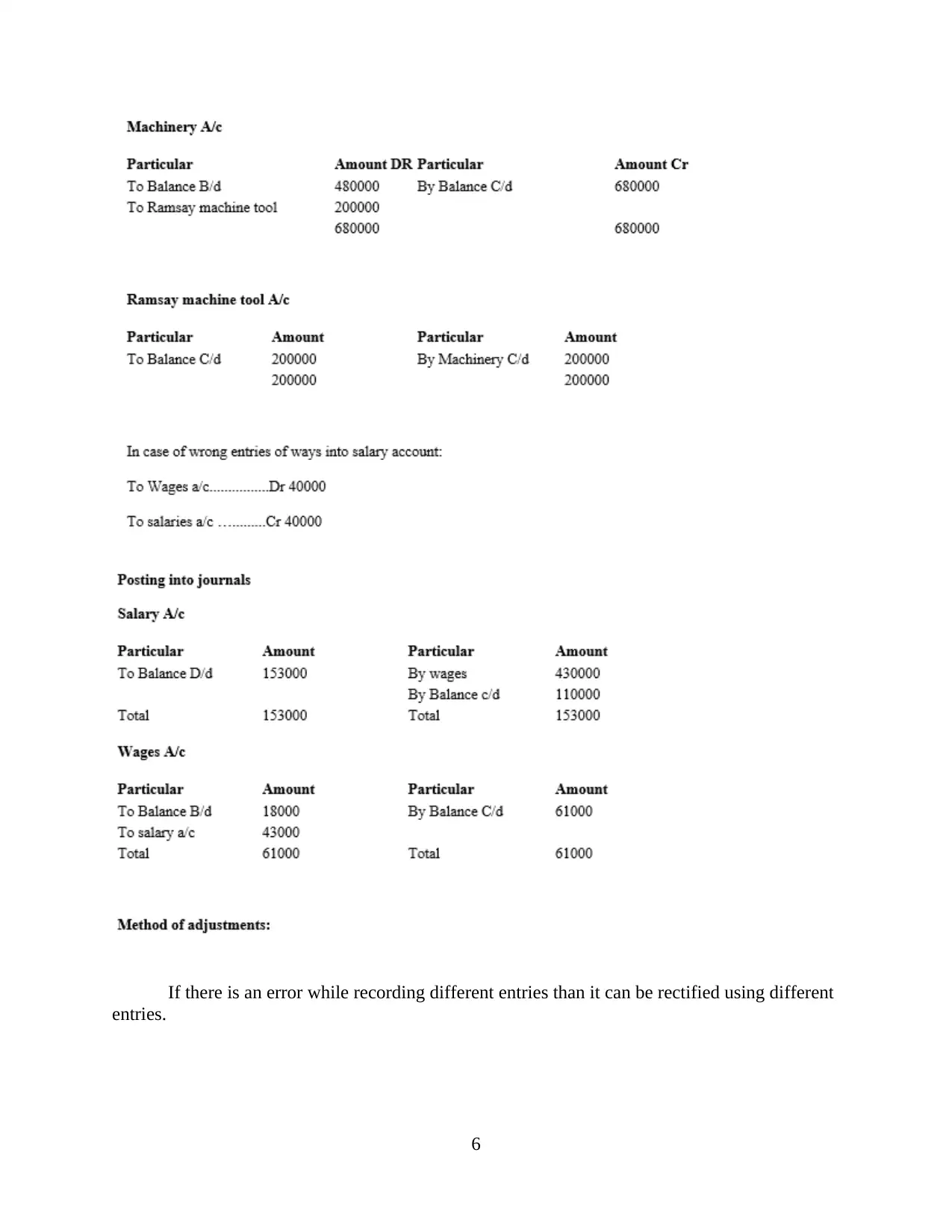
If there is an error while recording different entries than it can be rectified using different
entries.
6
entries.
6
⊘ This is a preview!⊘
Do you want full access?
Subscribe today to unlock all pages.

Trusted by 1+ million students worldwide
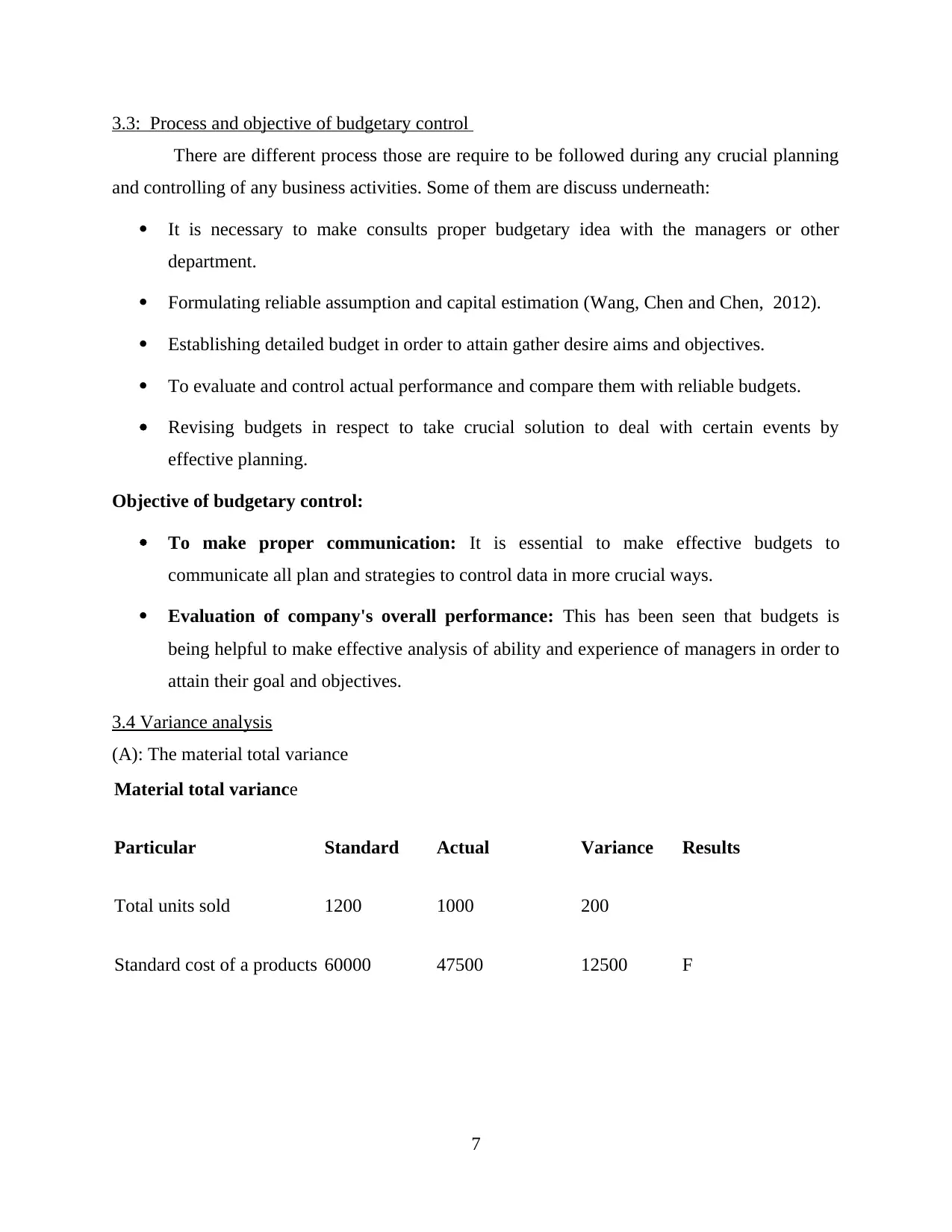
3.3: Process and objective of budgetary control
There are different process those are require to be followed during any crucial planning
and controlling of any business activities. Some of them are discuss underneath:
It is necessary to make consults proper budgetary idea with the managers or other
department.
Formulating reliable assumption and capital estimation (Wang, Chen and Chen, 2012).
Establishing detailed budget in order to attain gather desire aims and objectives.
To evaluate and control actual performance and compare them with reliable budgets.
Revising budgets in respect to take crucial solution to deal with certain events by
effective planning.
Objective of budgetary control:
To make proper communication: It is essential to make effective budgets to
communicate all plan and strategies to control data in more crucial ways.
Evaluation of company's overall performance: This has been seen that budgets is
being helpful to make effective analysis of ability and experience of managers in order to
attain their goal and objectives.
3.4 Variance analysis
(A): The material total variance
Material total variance
Particular Standard Actual Variance Results
Total units sold 1200 1000 200
Standard cost of a products 60000 47500 12500 F
7
There are different process those are require to be followed during any crucial planning
and controlling of any business activities. Some of them are discuss underneath:
It is necessary to make consults proper budgetary idea with the managers or other
department.
Formulating reliable assumption and capital estimation (Wang, Chen and Chen, 2012).
Establishing detailed budget in order to attain gather desire aims and objectives.
To evaluate and control actual performance and compare them with reliable budgets.
Revising budgets in respect to take crucial solution to deal with certain events by
effective planning.
Objective of budgetary control:
To make proper communication: It is essential to make effective budgets to
communicate all plan and strategies to control data in more crucial ways.
Evaluation of company's overall performance: This has been seen that budgets is
being helpful to make effective analysis of ability and experience of managers in order to
attain their goal and objectives.
3.4 Variance analysis
(A): The material total variance
Material total variance
Particular Standard Actual Variance Results
Total units sold 1200 1000 200
Standard cost of a products 60000 47500 12500 F
7
Paraphrase This Document
Need a fresh take? Get an instant paraphrase of this document with our AI Paraphraser
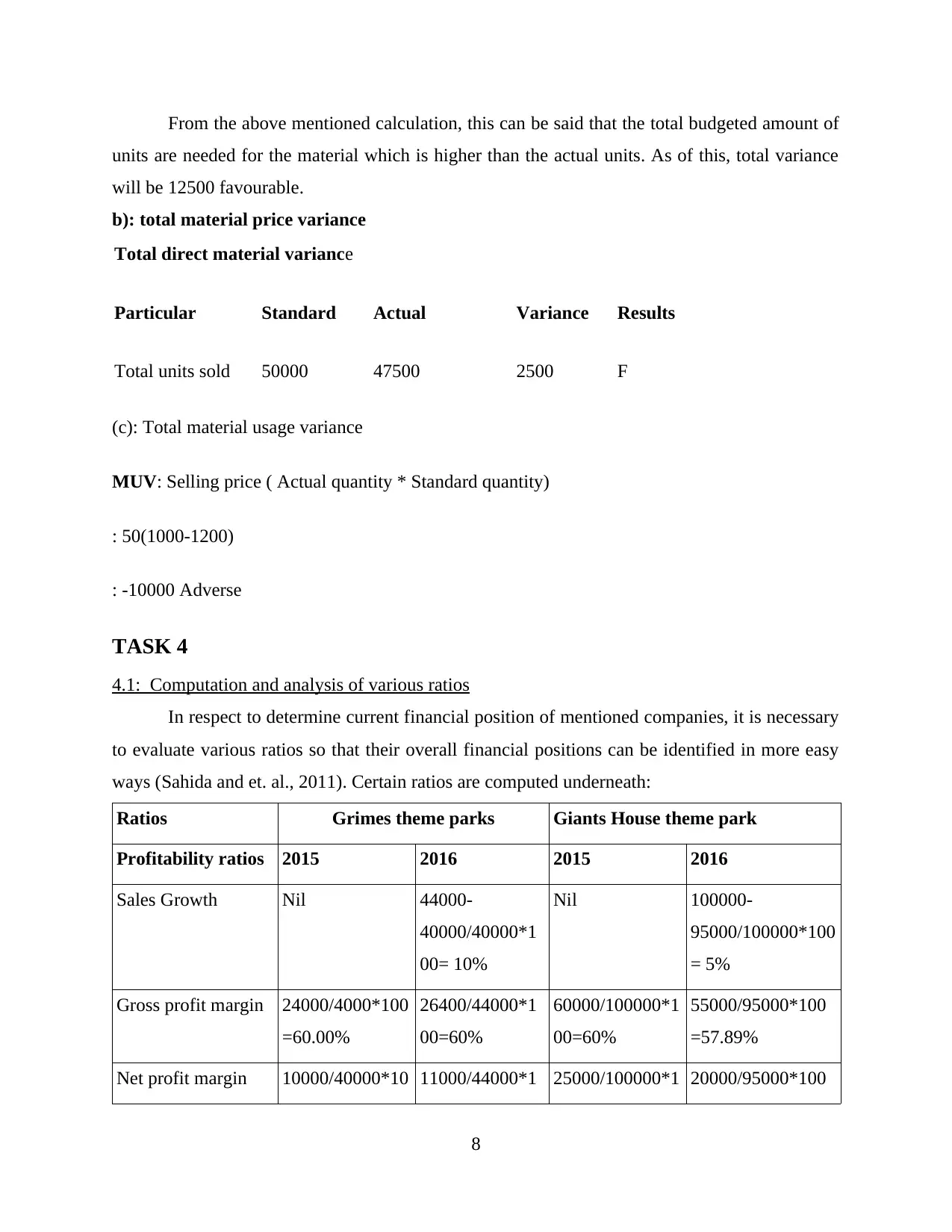
From the above mentioned calculation, this can be said that the total budgeted amount of
units are needed for the material which is higher than the actual units. As of this, total variance
will be 12500 favourable.
b): total material price variance
Total direct material variance
Particular Standard Actual Variance Results
Total units sold 50000 47500 2500 F
(c): Total material usage variance
MUV: Selling price ( Actual quantity * Standard quantity)
: 50(1000-1200)
: -10000 Adverse
TASK 4
4.1: Computation and analysis of various ratios
In respect to determine current financial position of mentioned companies, it is necessary
to evaluate various ratios so that their overall financial positions can be identified in more easy
ways (Sahida and et. al., 2011). Certain ratios are computed underneath:
Ratios Grimes theme parks Giants House theme park
Profitability ratios 2015 2016 2015 2016
Sales Growth Nil 44000-
40000/40000*1
00= 10%
Nil 100000-
95000/100000*100
= 5%
Gross profit margin 24000/4000*100
=60.00%
26400/44000*1
00=60%
60000/100000*1
00=60%
55000/95000*100
=57.89%
Net profit margin 10000/40000*10 11000/44000*1 25000/100000*1 20000/95000*100
8
units are needed for the material which is higher than the actual units. As of this, total variance
will be 12500 favourable.
b): total material price variance
Total direct material variance
Particular Standard Actual Variance Results
Total units sold 50000 47500 2500 F
(c): Total material usage variance
MUV: Selling price ( Actual quantity * Standard quantity)
: 50(1000-1200)
: -10000 Adverse
TASK 4
4.1: Computation and analysis of various ratios
In respect to determine current financial position of mentioned companies, it is necessary
to evaluate various ratios so that their overall financial positions can be identified in more easy
ways (Sahida and et. al., 2011). Certain ratios are computed underneath:
Ratios Grimes theme parks Giants House theme park
Profitability ratios 2015 2016 2015 2016
Sales Growth Nil 44000-
40000/40000*1
00= 10%
Nil 100000-
95000/100000*100
= 5%
Gross profit margin 24000/4000*100
=60.00%
26400/44000*1
00=60%
60000/100000*1
00=60%
55000/95000*100
=57.89%
Net profit margin 10000/40000*10 11000/44000*1 25000/100000*1 20000/95000*100
8
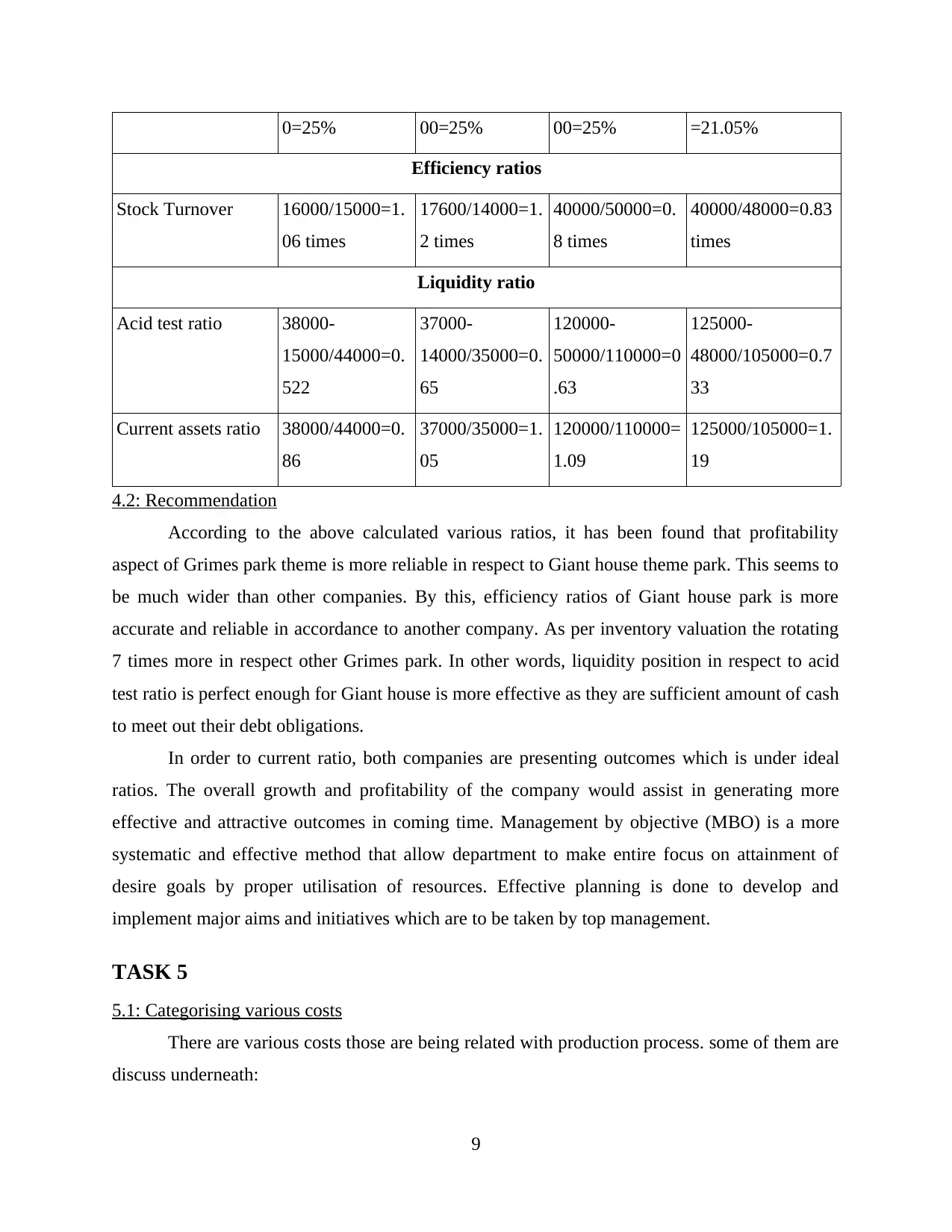
0=25% 00=25% 00=25% =21.05%
Efficiency ratios
Stock Turnover 16000/15000=1.
06 times
17600/14000=1.
2 times
40000/50000=0.
8 times
40000/48000=0.83
times
Liquidity ratio
Acid test ratio 38000-
15000/44000=0.
522
37000-
14000/35000=0.
65
120000-
50000/110000=0
.63
125000-
48000/105000=0.7
33
Current assets ratio 38000/44000=0.
86
37000/35000=1.
05
120000/110000=
1.09
125000/105000=1.
19
4.2: Recommendation
According to the above calculated various ratios, it has been found that profitability
aspect of Grimes park theme is more reliable in respect to Giant house theme park. This seems to
be much wider than other companies. By this, efficiency ratios of Giant house park is more
accurate and reliable in accordance to another company. As per inventory valuation the rotating
7 times more in respect other Grimes park. In other words, liquidity position in respect to acid
test ratio is perfect enough for Giant house is more effective as they are sufficient amount of cash
to meet out their debt obligations.
In order to current ratio, both companies are presenting outcomes which is under ideal
ratios. The overall growth and profitability of the company would assist in generating more
effective and attractive outcomes in coming time. Management by objective (MBO) is a more
systematic and effective method that allow department to make entire focus on attainment of
desire goals by proper utilisation of resources. Effective planning is done to develop and
implement major aims and initiatives which are to be taken by top management.
TASK 5
5.1: Categorising various costs
There are various costs those are being related with production process. some of them are
discuss underneath:
9
Efficiency ratios
Stock Turnover 16000/15000=1.
06 times
17600/14000=1.
2 times
40000/50000=0.
8 times
40000/48000=0.83
times
Liquidity ratio
Acid test ratio 38000-
15000/44000=0.
522
37000-
14000/35000=0.
65
120000-
50000/110000=0
.63
125000-
48000/105000=0.7
33
Current assets ratio 38000/44000=0.
86
37000/35000=1.
05
120000/110000=
1.09
125000/105000=1.
19
4.2: Recommendation
According to the above calculated various ratios, it has been found that profitability
aspect of Grimes park theme is more reliable in respect to Giant house theme park. This seems to
be much wider than other companies. By this, efficiency ratios of Giant house park is more
accurate and reliable in accordance to another company. As per inventory valuation the rotating
7 times more in respect other Grimes park. In other words, liquidity position in respect to acid
test ratio is perfect enough for Giant house is more effective as they are sufficient amount of cash
to meet out their debt obligations.
In order to current ratio, both companies are presenting outcomes which is under ideal
ratios. The overall growth and profitability of the company would assist in generating more
effective and attractive outcomes in coming time. Management by objective (MBO) is a more
systematic and effective method that allow department to make entire focus on attainment of
desire goals by proper utilisation of resources. Effective planning is done to develop and
implement major aims and initiatives which are to be taken by top management.
TASK 5
5.1: Categorising various costs
There are various costs those are being related with production process. some of them are
discuss underneath:
9
⊘ This is a preview!⊘
Do you want full access?
Subscribe today to unlock all pages.

Trusted by 1+ million students worldwide
1 out of 15
Related Documents
Your All-in-One AI-Powered Toolkit for Academic Success.
+13062052269
info@desklib.com
Available 24*7 on WhatsApp / Email
![[object Object]](/_next/static/media/star-bottom.7253800d.svg)
Unlock your academic potential
Copyright © 2020–2025 A2Z Services. All Rights Reserved. Developed and managed by ZUCOL.





